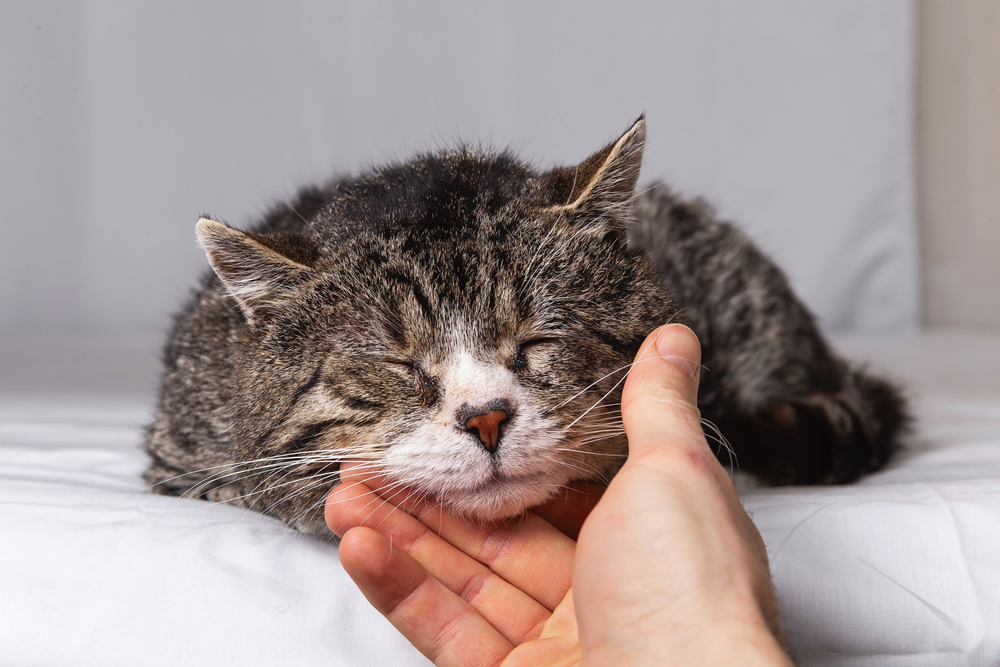Normal pet aging involves unavoidable physical health changes, such as stiff or painful joints, vision or hearing loss, and reduced organ function. Unfortunately, your pet’s brain is equally susceptible to normal age-related decline, and some pets experience more significant cognitive impairment, similar to Alzheimer’s disease in humans.
Complete the following quiz to determine if your senior pet’s behavior is a warning sign for cognitive dysfunction syndrome (CDS). Then, discuss your pet’s results with your Fremont Animal Hospital veterinarian.
Check the box next to each statement that applies to your pet.
❐ Your pet is older than 9 years of age
Age is the greatest CDS risk factor for dogs and cats. Unfortunately, the condition is frequently underdiagnosed because the signs can be subtle, or be mistaken for normal age-related decline. Although exact numbers are unknown, approximately 28% of dogs aged 11 to 12 and cats aged 11 to 14 experience CDS-related changes in social behavior. Prevalence increases significantly with age, with 50% of cats and nearly 70% of dogs older than 15 affected.
Physical health and behavior are closely linked. As your pet enters their senior years, closely monitor their daily routine (e.g., activity, attitude, mobility), and discuss any changes with their veterinarian.
❑ Your senior pet has difficulty recognizing you or familiar people
CDS is characterized by plaque-like deposits in the brain that disrupt normal function in key areas that control memory, learning, and awareness.
CDS-affected pets may hesitate before greeting their owner, act wary or fearful around familiar people or pets, or seem withdrawn. Fewer social interactions can also indicate vision loss or physical pain, so always discuss such changes with your veterinarian.
❐ Your pet seems disoriented or gets lost in their home or yard
CDS-affected pets often struggle to orient themselves in familiar places, including areas they know best, such as their home or yard. Common presentations include:
- Going to the hinged side of a door to be let in or out
- Getting “trapped” behind furniture or in the corner of a room
- Wandering from the yard
Disorientation is a significant risk for CDS-affected pets, because they may go missing, be hit by a car, or suffer a serious injury after falling from an unrecognized height or failing to navigate stairs. These risks are heightened by other age-related impairments, such as poor mobility and sensory loss.
❐ Your senior pet is having accidents in the home or not using the litter box
If your previously well-trained dog or cat has changed their elimination habits, they may be forgetting why they’ve gone outside or visited the litter box. CDS-affected dogs commonly have accidents soon after returning indoors, sometimes in front of their owner. Cats may eliminate near or on the path to or from the litter box. Accidents may be occasional or increase in frequency.
Fecal and urinary accidents indicate that your pet is struggling or unable to control their bladder, bowels, or memory. Therefore, you must not scold or punish your pet, which can lead to increased stress, anxiety, and confusion.
❐ Your senior pet’s sleep-wake cycle has changed
CDS alters the brain’s ability to regulate sleep and wake cycles, so affected senior pets will sleep more during the day and be more active at night. Human Alzheimer’s patients experience a similar condition, referred to as Sundowner’s syndrome. Nighttime activity commonly includes:
- Vocalization — Increased night vocalization is especially common among CDS-affected cats.
- Restlessness — Pets may pace, circle, or aimlessly wander.
❐ Your senior pet is uncharacteristically irritable, hyper, clingy, or nervous
Personality changes are perhaps the most distressing warning signs for pet owners. CDS-affected pets can exhibit uncharacteristic changes in temperament, activity level, and personality, such as:
- Increased irritability — Pets may be more sensitive to touch, handling, or their human or pet housemates, which can lead to defensive aggression, such as growling, hissing, biting, or scratching.
- Hyperactivity — Pets’ activity levels may increase, or they seem to move constantly.
- Attention-seeking — Previously independent pets may seem needy or constantly seek their owner’s reassurance and focus.
- Disinterest or self-isolation — Previously attentive pets may hide, avoid play or social interactions, or be more lethargic.
- Fearful or anxious behavior — Confident pets may grow cautious, worried, or nervous about everyday sounds, situations, or being left alone.
❐ Your senior pet struggles to learn new skills or respond to known cues (i.e, commands)

You can teach an old pet new tricks, unless they’re suffering from CDS, which affects the brain’s learning centers, and makes understanding and recalling new information more difficult. At the same time, damage to the brain areas responsible for memory impair their ability to follow well-known instructions, such as “Stay” or “Come.”
If you’ve checked one or more boxes, your pet may be at risk for or currently suffering from CDS. Although the condition is incurable, therapeutic treatments are available to slow its progression. Your pet’s veterinarian will perform a complete physical examination and diagnostic testing to rule out other age-related health conditions and give you tips on preserving your pet’s cognitive function and enhancing their quality of life.
Contact the Fremont Animal Hospital team to schedule your senior pet’s appointment or schedule their visit online, so we can improve their golden years.






















Leave A Comment